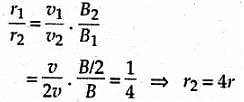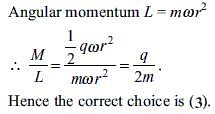Test: Moving Charges and Magnetism - 2 - CUET Humanities MCQ
15 Questions MCQ Test Agriculture Practice Tests: CUET Preparation - Test: Moving Charges and Magnetism - 2
Which of the following is not a fact about magnetism?
An electron beam is moving between two parallel plates having an electric field 1.125 x 10-6 N/m. A magnetic field 3 x 10-10 T is also applied so that the beam does not deflect. The velocity of the electron is
| 1 Crore+ students have signed up on EduRev. Have you? Download the App |
An α-particle with a specific charge of 2.5 × 107 C-kg-1 moves with a speed of 2 × 105 ms-1 in a perpendicular magnetic field of 0.05 T. Then, the radius of the circular path described by it is
A direct current is sent through a helical wire coil or spring. The coil
The direction of the force experienced by a charged particle, moving with a velocity v in a uniform magnetic field B, is
When an electron moves in a magnetic field in a direction perpendicular to the field, then its path will be
An electron of mass m and charge q is travelling with a speed v along a circular path of radius r at a right angle to a uniform magnetic field of intensity B. If the speed of the electron is doubled and the intensity of magnetic field is halved, the resulting path would have a radius
A straight section PQ of a circuit lies along the x-axis from x = - a/2 to x = a/2 and carries a current I. The magnetic field due to the section PQ at point x = +a will be
A power line lies along the East-West direction and carries a current of 10 A. The force per unit length due to the Earth's magnetic field of 10–4 T is
A circular coil of radius r, having n number of turns and carrying a current I, produces a magnetic field of magnitude B at its centre. B can be doubled by
A charged particle is released from rest in a region of steady and uniform electric and magnetic fields, which are parallel to each other. The particle will move in a
An electron of charge e moves in a circular orbit of radius r around the nucleus at a frequency v. The magnetic moment associated with the orbital motion of the electron is
Which of the following statements are correct for induced magnetism?
(a) It is defined as the magnetism acquired by a magnetic material kept near a magnet.
(b) A similar polarity develops on the magnet and the material in its vicinity.
(c) It precedes attraction.
(d) It is permanent.
A particle of charge q and mass m moves in a circular orbit of radius r with an angular speed ω. The ratio of the magnitude of its magnetic moment to that of its angular momentum depends on
A wire of length L metres carrying a current I amperes is bent in the form of a circle. The magnitude of the magnetic moment is




 cm = 16 cm
cm = 16 cm








 r2I =
r2I = 















